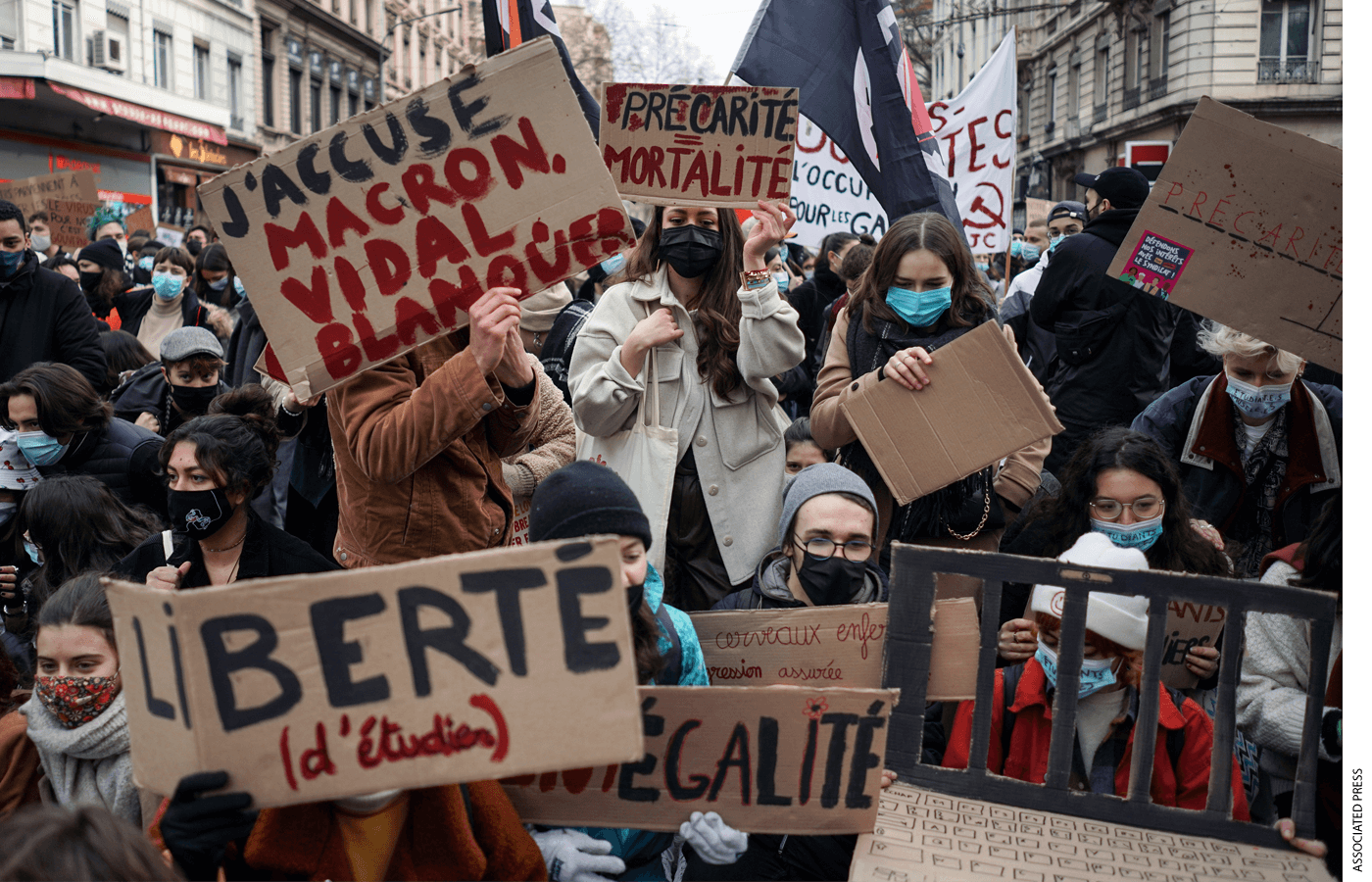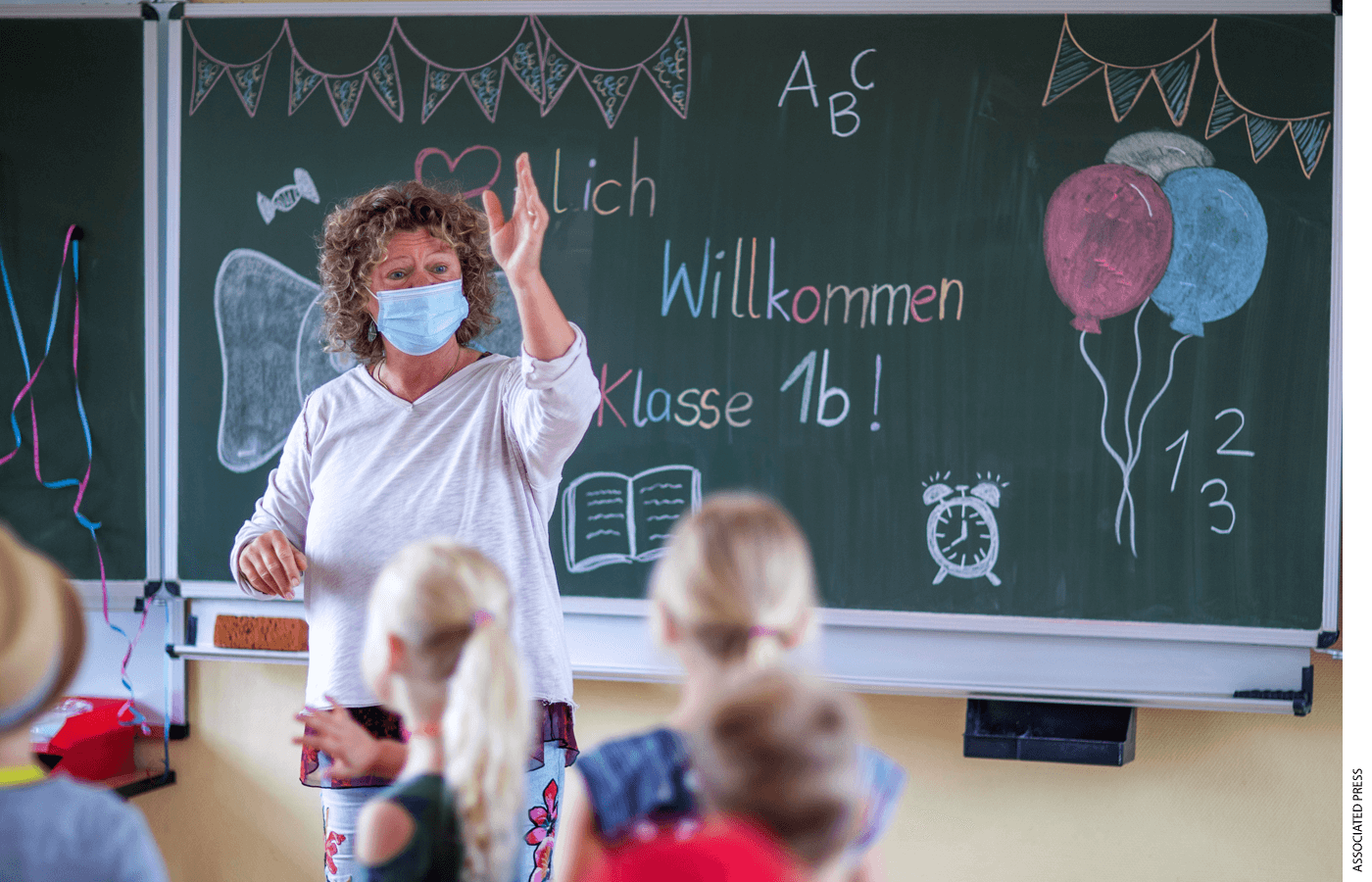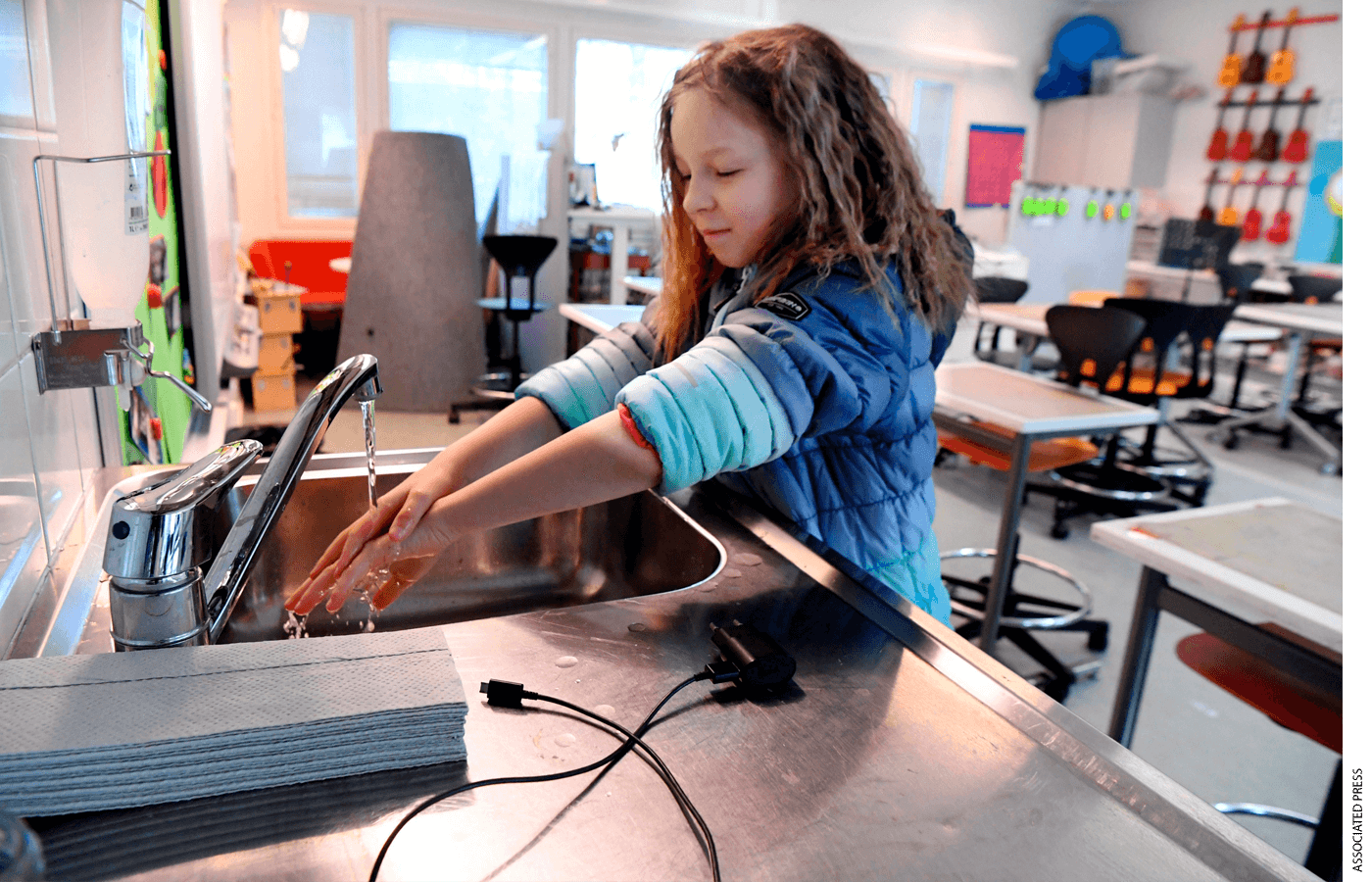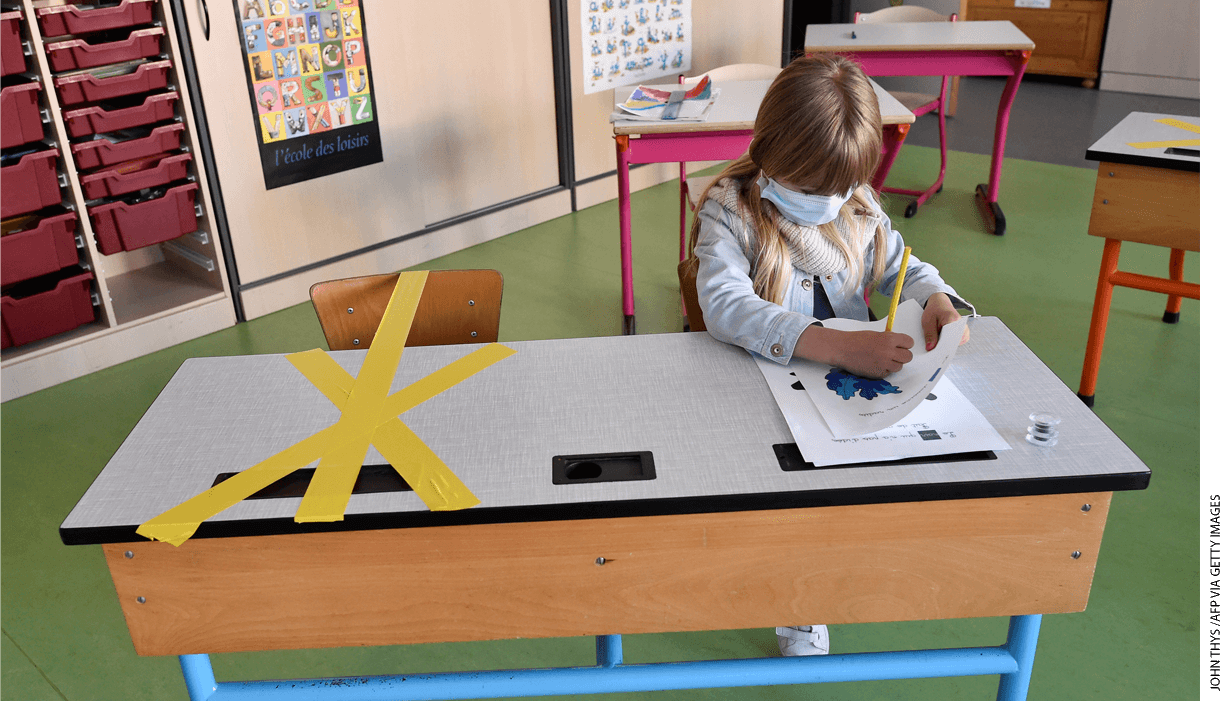As American schools reopen for the fall—or attempt to, amid a new surge of coronavirus cases related to the Delta variant—what, if anything, can be learned from the experience of Europe?
Governments in Europe have wrangled over when to close and reopen schools, weighing the risk of children spreading the virus at school against the economic and education-related disruptions of keeping them at home. During the first months of the pandemic, when most schools were shut, research supported reopening schools for younger age groups, given the evidence of low infection in and from young children. Governments attempted to follow this science and have, from almost the beginning of the pandemic, tried to keep schools open as much as possible to avoid children losing out on education. Teachers unions, on the other hand, have tried to keep the schools closed.
Teachers unions have persistently argued that schools were too unsafe for teachers, who could risk contracting the virus and spreading it to their communities and vulnerable people. The unions put enormous pressure on governments to close down schools, even when governments deemed it safe enough to open or partially open them. When the unions were unsatisfied with government action, they sought to block their members from returning to work, filed lawsuits, issued strike threats, and held strikes and mass protests to compel governments to delay school reopenings. When scientific advice indicated it would be safe for more children to return to school in England at the beginning of June 2020, Mary Bousted, the leader of the National Education Union, told members not to engage with any government planning based on a wider reopening of schools and hit schools with 22 pages of demands, including a ban on grading. The union also launched the Escalation App, a smartphone app devised to help teachers challenge attempting to keep classrooms open during lockdown and initiate local strike actions. Across the channel, the French teachers unions— the most strike-prone unions in Europe—launched three major strikes during the pandemic, criticizing the government’s handling of the crisis and calling for more teachers, higher salary, and an increase to the 2021 education budget.
Teachers-union activism has routinely goaded governments into accepting union demands and allowing politics rather than science and medical advice, to drive decisions. Parents, who are in favor of some in-person learning for children, have been largely marginalized in the political battles of school closures and reopenings. They have found it frustrating when governments negotiate with unions rather than parents, who prefer to trust public-health professionals. Consequently, more resourceful parents have sought to find alternative ways of schooling, while low-income families, who often do not have access to such opportunities, have had no other choice but to live with union-enforced decisions.
There’s not yet been a careful accounting of how many European schools were closed due to union pressure rather than medical advice. The European teachers unions, well-organized and resourceful, have sought to be at the forefront of influencing political decisions about whether or when to send children back to schools. How the unions’ demands on health and safety measures come into play and how much power they have varies from country to country, however.
The following offers a brief tour on how teachers unions pursued their “teachers first” agenda at the beginning of the pandemic in five European countries.
England
On March 23, 2020, Britain went into its first lockdown, which meant schools were closed except for the children of key workers. The two largest teachers’ unions, who had pressured for the lockdown to take place earlier, supported the government’s decision. But when the government attempted to open primary schools to some children on June 1, 2020, when case numbers were down, the teachers unions collided with the government. The unions insisted that schools should not even consider reopening until the number of new Covid-19 cases and deaths had fallen even further and an effective program of mass testing and contact tracing was in place.
The union campaign succeeded in derailing government plans for the wider school openings. The government announced that it was abandoning plans for all primary-school age groups to return to school for four weeks before the summer term ended. A government survey had reported that, on June 18, 2020, only around one third of Year Six pupils in primary schools (10- and 11-year-olds) were receiving in-person learning. Instead, most primary-school children returned to classes in early September, almost six months after schools closed. A more detailed survey by the National Education Union, with responses from about 11,000 of England’s 16,769 primary schools, found that 44 percent of schools did not open at all on June 1, while another 21 percent did open more widely but on a smaller scale than the government requested. Only 35 percent of schools acted on the government’s instructions.
Most of the primary schools that remained closed were controlled by local authorities. A number of local authorities, mostly led by the Labour party, had advised schools against wider reopening, though a few Conservative-led authorities had also expressed concerns. In sharp contrast, the academy primary schools run by trusts, which are similar to American charter schools and make up about 35 percent of primary schools, have been more eager to reopen their doors. A similar divide can be observed for school reopening at the secondary level. The local authority secondary schools have tended to be closed for longer than the academy secondary schools, which make up about 77 percent of secondary schools and have sought ways of keeping schools open for as for long as possible, in line with medical and scientific advice.
A trust-wide approach was arranged to manage risk assessment and shape local response to national Covid-19 guidelines, as well as to develop remote learning and quickly source equipment for pupils to use at home. Likewise, the private schools, with their greater resources, raced ahead, offering 74 percent of their students online lessons, compared with 6 percent in the state sector. Private schools also graded students’ work, provided pastoral support, and held parent meetings. Some private schools even formed partnerships with state schools that ignored the union pressures.
The pattern that has emerged, and appears to have persisted throughout the pandemic, is that the local-authority-run school sector, in which teachers unions are rooted, has kept schools closed for longer periods and has been more reluctant to return to in-person learning, whereas the trust-run academies have tended to be open longer and arrange online learning activities and other forms of alternative education more extensively during lockdowns. Since 2010, the rollout of the academy program, which is still ongoing, has resulted in an eroded power base for the teachers unions, though the unions have continued to cause disruptions in what is left of the authority-run school sector.

France
Schools in France were among the first to close on March 17, 2020, during Europe’s first lockdown, but when President Macron announced plans to get schools out of lockdown on May 11, 2020, the largest teachers unions planned to block the effort. The unions claimed that the 56-page raft of safeguarding rules issued by the government, which mandated small classes, timed arrivals at schools, and compulsory masks for all teachers and students from the age of 11, was insufficient. Unions then countered with their own demands. Macron sought to take the spike out of the mounting conflict by saying that it was parents, not unions, who should decide whether to send their children back to school. As a result, most schools began to open. Some 40,000 primary and middle schools reopened, which meant that around 1 in 5 primary-school students returned to class.
During the second lockdown beginning on October 28, 2020, the French government vowed to keep schools open, and the teachers unions retaliated with strikes. The unions claimed that the health of teachers was at risk due to insufficient protocols against the virus. Macron tried to allay concerns by allowing secondary schools to offer more online teaching, under the condition that students take at least 50 percent of their classes at school. The unions refused to accept this compromise and demanded the government hire more teachers to enable smaller class sizes. Protests continued despite several parent organizations demanding schools open to continue in-person learning.
On January 25, 2021, the teachers unions yet again staged a national strike to oppose the government response to the pandemic and repeated their demand for better working conditions and higher salaries. Education Minister Jean-Michel Blanquer had announced a roughly $460 million package to bump up teachers’ salaries back in April 2020, which took effect in January 2021, but the unions claimed this was not enough. A march through the center of Paris and other protests throughout the country caused serious disruptions to many schools. A third strike was organized in March 2021.

Germany
The German government and the main teachers unions did not clash seriously over school reopenings, as Covid-19 was handled relatively well in the early months of the pandemic. From March 13 to April 23, 2020, all of Germany’s 16 states closed schools. During that time, public adherence to government restrictions got daily cases of the virus into the single digits, resulting in many children returning to school long before the summer holidays. Schools opened fully in August 2020 and were, for the most part, working normally until another lockdown started in 2021. Ample testing and thorough contact tracing have kept disruption to a minimum, impacting just a few students or a single class for a few days or weeks.
Under Germany’s federalized system, school closures and openings fall under the jurisdiction of the 16 states. The teachers unions, who for decades have advocated for stronger national control of education, complained that the guidelines produced by the Conference of Ministers of Education—a body that coordinates education polices—were “unhelpful and unpractical” and left too much leeway for the individual states to make their own plans. The unions demanded fully standardized safeguarding rules that every state should follow “step-by-step.” Some centralized coordination and standardization measures resulted, but the states, who lobby for stronger autonomy, believes imposing a standard solution for all schools would be restrictive. The states’ crisis management teams adopted the Conference of Ministers of Education procedures for reopening. Regional union representatives were part of the crisis management teams in only some of the states; in others, they were not consulted.
The relations between the government and teachers unions became increasingly tense during the wave of new infections that swept Germany in January 2021. On March 12, 2021, Federal Education Minister Anja Karliczek said that nationwide school closures were not on the agenda and that efforts were being made to maintain normal operations for as long as possible. Another lockdown and school closures followed. Elementary schools in more than half of the Germany’s states reopened in late February 2021 after two months of closure. This move came as case numbers were flattening in those states, even though case numbers were rising in others. Karliczek defended the decision to reopen schools, saying younger children in particular benefit from learning together in groups. She expressed confidence that state education officials, who were in charge, would consider infection numbers when deciding to reopen. Union leader Marlis Tepe lamented that states might reopen schools, regardless of the spread, and were taking “a high risk for the health of teachers, students, and their parents.”

Finland
In Finland, the government announced a state of emergency on the March 16, 2020, and closed all schools with almost immediate effect. The teachers union in Finland endorsed the decision and had participated in discussions with the government in the run up to the decision to close schools. The Finnish teachers union is a force to be reckoned with. It is the only trade union for teachers in the country, 97 percent of teachers are members, and it is deeply integrated into the governmental subsystem of boards and commissions, as well as the education ministry. Throughout the pandemic, the union has influenced many government decisions on safety measures in schools, distance learning, equipment, programs, teacher education, additional support grants, and much more. At the same time, the union sought to block local authorities from allowing teachers to deliver their distance teaching from school premises, as it has been active in trying to convince employers to allow teachers work from home.
When research came out showing it was low risk to open schools and the government endorsed the findings, the union hit back. On April 18, 2020, Asko Järvinen, chief physician of infectious diseases at the Hospital District of Helsinki and Uusimaa, said that international studies indicated school closures were “perhaps the least effective way” to slow down the pandemic. The following day, Prime Minister Sanna Marin announced plans to reopen the schools. A union representative complained: “As a teacher, I don’t understand why it is worth risking the health of teachers, children, and their loved ones.” Given the success in containing the spread of Covid-19, the government maintained that children’s rights to education outweighed the risk of going back to school and pressed ahead. Education Minister Li Andersen said that the government was “unmoved” by the union’s “negative opinion about the reopening of schools before the summer break.”
Sweden
Sweden is an outlier. Sweden never closed schools, judging the benefits of leaving schools open to outweigh the risks. Unlike most children across Europe, Swedish students nationwide have not missed a single day of school due to the coronavirus. The country’s public-health authorities made the decision to keep schools open at the start of the outbreak and stuck with it, even when death rates were ten times higher than in the other Nordic countries. Classes have been compulsory for all pupils up to the age of 16. Local authorities decide how to handle possible outbreaks and have the option to close individual schools. The country’s two teachers unions criticized this decision and have called for national guidelines on whether schools should be closed. Since the unions were unable to overturn the government decision, they have focused their efforts on emphasizing the safety of their members. They also raised concerns over dividing classrooms into smaller groups, as this increased teachers’ work hours and created staffing shortages. Keeping schools open in Spring 2020 did not lead to infection rates among students that were higher than those in neighboring Finland, where schools were temporarily closed.
Bringing It Back to the U.S.
Governments in Europe are now facing a mammoth task in narrowing the gap between disadvantaged children and their peers from higher-income families. Quality school-catchup time is paramount. Schools face an enormous task. Governments will consider measures such as extending learning time into what are usually vacation weeks, adding additional hours to the school day, and offering school-based homework and personal tutoring for students, all of which will increase demands on teachers. Unions strongly oppose such measures. The hostility between European governments and teachers unions will likely continue or perhaps even intensify. In the face of union power, governments have typically scaled back their efforts to make even incremental changes.
The union influence is also strong in international institutions. Governments, which increasingly rely on the Organization for Economic Cooperation and Development in improving their education systems, are likely to receive policy advice that has been influenced by the unions. As the importance of the OECD in developing global education policies has increased over the years, so has the influence of the teachers unions. After years of effective lobbying, they are now at the heart of the OECD decision-making processes. Education ministers from OECD member states (only twenty high performers) cannot attend the most important meeting in the International Summit of the Teaching Profession at the Education Directorate OECD without being accompanied by representatives from the teachers union and Education International, a union umbrella group, and they must be given the same amount of speaking time as the ministers. As co-chairs, they decide, together with the OECD, the agenda for every meeting and the format of these, and they have a say on the narrative of the reports published, especially the Teaching and Learning International Survey. In these reports, teachers’ well-being is ranked higher than student outcomes and learning achievements.
That teachers unions in Europe entered the pandemic crisis with teacher-centric demands, almost succeeding in silencing the “parent voice,” may seem like a familiar story to Americans. A recent study of 10,000 of roughly 13,000 school districts in the United States shows that the most important factors in determining reopening plans for the 2020–21 school year were local politics and the teachers unions. After controlling for urbanicity, partisanship, and the Covid-19 case rates in a district, the study observed that in larger districts, where unions are more likely to be powerful in politics and have collective bargaining, schools were far less likely to hold in-person classes for children.
In Europe as in the U.S., without a strategy to deal with unions, governments seeking to reopen school for in-person education and to help students recover learning lost in the pandemic will find success elusive.
Susanne Wiborg is co-author of Comparative Politics of Education: Teachers Unions around the World and reader at UCL Institute of Education, London.



